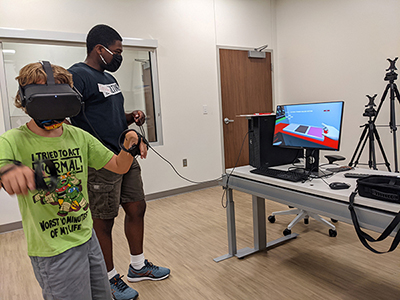MMI Camp Uses VR Games to Achieve Therapy Goals
August 30, 2021

|
In August, the Munroe-Meyer Institute held a two-week Hand Arm Bimanual Intensive Training (HABIT) camp.
The institute has held the camp three times in the past. The purpose of the camp is to allow children with cerebral palsy and other conditions to work on bimanual therapy (using both hands to complete a task) in the form of play.
This year, however, there was a new twist with the introduction of virtual reality games, designed by James Gehringer, PhD, and the MMI Virtual Reality Lab, that incorporated the therapeutic play concept into video games.
The idea for the games, which Dr. Gehringer and his team have been refining for several years, grew out of the previous HABIT Camps, the first of which was held in 2015.
"The goal of the camp is for the kids to do as many activities as possible that need both hands," said Mindy Oetter, MMI occupational therapist, who took part in the first HABIT camp as well as this year's version. "So the children are constantly using their involved hands to hold onto a toy or grasp and release as part of an activity. The idea is for them to do it by themselves."
Dr. Gehringer's games, which were developed with initial grant support from the Munroe-Meyer Guild, use bimanual activity as part of the gaming process. Dr. Gehringer's lab worked with physical and occupational therapists to refine the movements necessary for each game -- so a child can shoot down alien ships, for example, or scoop ice cream.
Dr. Gehringer also took baseline measurements from the campers. After the camp, he and his team will compare output measures to see if the camp, with its VR component, had a measurable positive impact for the campers.
"Doing 40 hours of therapy across 10 days, kids tire out," Dr. Gehringer said. "If we can tap into something more familiar, like videogames, and base the movements in the games off established treatment practices, we're hoping to see an impact with the children not even realizing how hard they're working.
"The kids enjoyed the change of pace, the environment, and they liked some of the games," he said. "You know kids, they have no filter, so we got a lot of useful feedback about what we can do to make games more enjoyable."
The VR aspect of the camp used a challenge system, setting goals for the kids - as individuals and as a group - to reach within each game.
"By setting parameters for the time or goals to boost the intensity of the activity, we're hoping to increase motor learning," Dr. Gehringer said. "This is really our first validation of the physical therapy software we built. We're hoping to see positive results and build from there - and if not, we will see how we can change the games to improve the outcomes."
Occupational therapist Monica Pleiss, OTD, who has been involved in HABIT camps since their inception, said it was interesting to see the children's reactions to the VR aspect.
"This was an additional tool to see if we could increase progress and improve their use of their involved hand and arm," Dr. Pleiss said. "It was interesting to watch how those two things integrated. Some of the children really enjoyed the videogames, and some of the younger kiddos had less interest. But Dr. Gehringer was able to adapt a lot of the games, changing things up to engage the kids a little more when he could, too.
"I'm looking forward to seeing what kind of data he gets."
Dr. Pleiss said she and other occupational and physical therapists worked with Dr. Gehringer to determine the preferable movements for each game -- many drawn from the original HABIT camps -- but this was the first time she'd seen the games being used.
"Seeing the games themselves, that gave all of us a lot of ideas for other games we could help create for the future," she said.
University of Nebraska Lincoln student and LEND trainee Jadyn Cattau volunteered at the camp. She was paired with a buddy for the two weeks.
"Individuals with disabilities know when they're going to therapy, so to incorporate those exercise into a fun, educational and engaging, social camp is amazing for these kids," said Cattau, who hopes to become an occupational therapist. "It was really exciting and beneficial to see these kids -- not knowing that they were practicing -- just exercising and strengthening their arms."
Dr. Gehringer praised the collaboration of the PT and OT departments, as well as his many volunteers, and thanked Nicole Giron, director of the MMI Department of Recreational Therapy, for her input on how to run a camp.
"It was a huge team effort from MMI and UNMC as a whole," he said.







